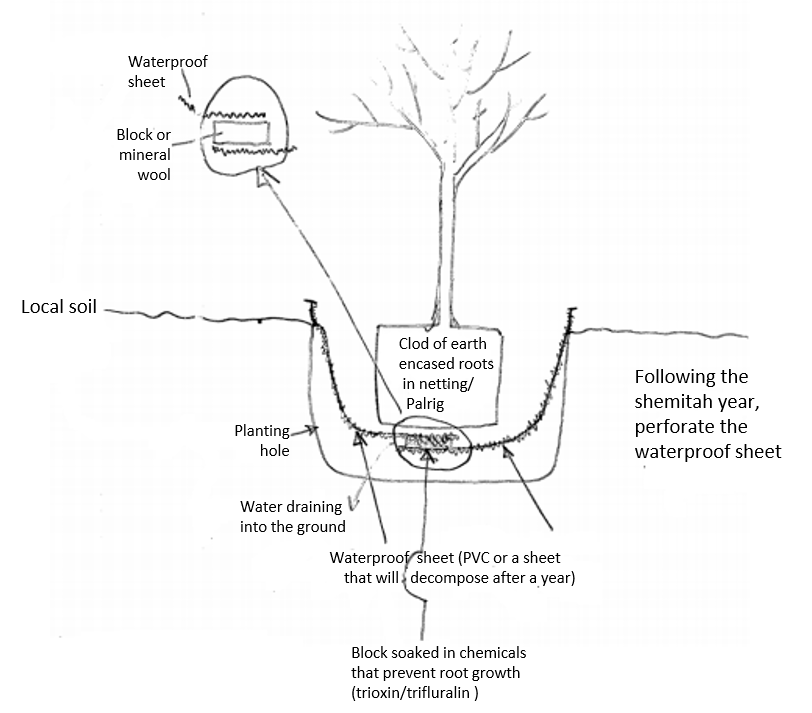Forests Clerk - Transplanting trees during shemitah

The halachic and practical guide from the forest clerk at the ministry of agriculture about transplanting plants
See here to print the article as a PDF file.
See here for the Hebrew PDF file.
ATTN: Transplanting and planting trees during shemitah
Ministry of Agriculture and Rural Development Forests Clerk guidelines, following guidance by agronomist Motty Shomron and Rabbi Yehuda Amichay of Torah VeHa'aretz Institute
Background
Under Jewish law, during the shemitah year, it is prohibited to plant trees and plants, since transplanting trees is also considered planting. Furthermore, under Jewish law it is forbidden to transplant trees during shemitah.
The Forests Ordinance §15A(b) states that the Forests Clerk should take into consideration the shemitah year for alternative planting, when requested by the licensee:
"… as for determining the planting date, the Forests Clerk should consider, if requested by the licensee, the date of the shemitah year."
A. Transplanting
Guidelines for the Forests Clerk to issue licenses:
As a rule, the law allows issuing transplant licenses also during the shemitah year. Those requesting to transplant trees while observing the laws of the shemitah year will receive a regular license from the Forests Clerk and will incorporate the specifications proposed below.
Specifications and charts are appended.
B. Alternative planting
Under §15A(b) of the Forests Ordinance, the Forests Clerk will determine the date of alternative planting while considering the shemitah year, if requested by the licensee applicant.
Guidelines for Forests Clerk
The date for alternative planting will be determined, in coordination with the licensee and in consideration of his request, vis-à-vis the shemitah year. There are no other changes in the other conditions, including the method of calculation and collection of bank guarantee for realization.
Transplanting Guidelines During the Shemitah Year
When a delay in the transplant of trees can significantly undermine a project and cause damage, the technical specifications below make it possible to transplant during the shemitah year into a hole covered by a waterproof sheet, which will create a closed receptacle of sorts. Following the shemitah year, it will be necessary to perforate the sheet to allow the roots to penetrate the confines of the sheet and take root in the local soil.
Work stages: precise specifications required*
-
- Prepare tree for transplant
- Wrap the clod of soil encasing roots in netting/Palrig/hessian cloth and tie it to prevent crumbling.
- Prepare the planting hole in its final location. The dimensions of the hole should be a diameter of 30 cm greater than the diameter of the clod of earth encasing the roots.
- Cover the planting hole with two waterproof plastic sheets so that there is an overlap of approximately 30 cm between sheets (see picture appended).
- Insert a block of material that absorbs, ventilates, and allows water to go through, which was soaked in trioxin/trifluralin (material that prevents the roots to sprout between the two sheets to prevent the roots to grow outside of the sheets, but that allow to drain the excess water).
- Attach both plastic sheets to one another with duct tape to prevent the roots from penetrating the ground.
- Plastic sheets will protrude approximately 20 cm above the ground level.
- After the shemitah year, perforate the sheet to encourage the tree to take root in the ground.
- Proposals for alternative technical specifications will be received happily, and will be subject to the halachic examination of the Shemitah Committee.
Forests Clerk, Ministry of Agriculture and Rural Development, Derech HaMaccabeem, Rishon LeZion,
P.O. Box 30 Beit Dagan 50250 Tel: 03-9485816 Fax: 03-9485264 E-mail: trees@moag.gov.il
Technical specifications for transplanting trees during the shemitah year
Proposal of Yisrael Talon and Motti Shomron (Torah VeHa'aretz Institute)





